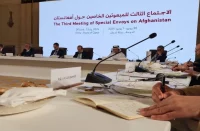A decade since the terrorist attack that shook the US on September 11, 2001, we are at the point where it is appropriate to revisit the lessons the world learned from the drama and to reassess its global impact. Instead of ending with some kind of a result that could be offered as its justification, the war on terror originally proclaimed under G. Bush morphed into a phenomenon completely unrelated to the fight against terrorism. While the 2001 NATO sting against the Talibs in Afghanistan could, albeit with limited credibility, count as a response to the terrorist onslaught, the West’s further steps clearly combined into a campaign for a redistribution of global resources and power in which terrorist groups with nominally anti-Western agendas routinely surfaced in the roles of NATO’s key partners.
In the process – exactly by the anniversary of the September 11 attack – the US and NATO scored another victory as Libya’s armed opposition took Tripoli. Operation Unified Protector military spokesperson Col. Roland Lavoie expressed support for the decision made by National Transitional Council of Libya to shift its decision-making center to the capital and US Department of State spokesperson Victoria Nuland praised Libya’s neighbors for their contribution to the resolution of the conflict, saying that Tunisia, Egypt, and Algeria cooperated closely with Washington for months and continued to work with the UN on border control procedures and refugee issues.
Col. Lavoie and Mrs. Nuland shyly failed to acknowledge the contribution to the “resolution of the conflict” made by Al Qaeda which was the West’s main ally in the Libyan campaign. Al Qaeda’s Libyan Islamic Fighting Group and Organization in the Islamic Maghreb which teamed up back in 2007 were in fact the drivers behind the opposition’s eventual triumph in Libya. Leader of the duo Abdel-Hakim Belhaj headed the rebels who stormed Tripoli and took the position of the Tripoli military council’s chief in the wake of the seizure of the city. Members of the Libyan Islamic Fighting Group freely admit staying in touch with Al Qaeda over the past years but do express skepticism over Bin Laden’s unrealistic views, indicating that they rather gravitate to Taliban leader Mullah Omar.
According to UN sources, the Libyan Islamic Fighting Group maintains links with Algerian and Moroccan Islamists, including the organizations responsible for the 2003 Casablanca terrorist attack against Western citizens, and poses a direct threat to the countries of West and South Europe. The Libyan Islamic Fighting Group runs an extensive network of cells in Spain, Italy, and France, and the de facto ascension of its members to power in Libya may enable terrorists to confront with their own terms the international bodies to be involved in the anticipated post-conflict reconstruction of the country. Moreover, considering that the CIA and Al Qaeda are known to have launched operations jointly in the past, it appears likely that the US would employ Belhaj and his brethren in the unfolding game in the Greater Middle East, particularly in Syria and Iran.
Roughly when, with the blessing from the National Transitional Council of Libya, Belhaj’s militants were getting entrenched in Tripoli, politicians and diplomats convened in Algeria to voice their concern over the escalating threat of terrorism at a UN-backed conference of North African countries. The forum stressed that, by boosting arms circulation and migration flows, the armed conflict in Libya exposed the Sahel and Sahara zone to new security risks. Experts warn that at the moment “Al Qaeda in the Islamic Maghreb” is active in a region with the area of 8 million square kilometers spanning Algeria and Marocco along with Niger, Mali, and Mauritania. Mali’s foreign minister Soumeylou Boubèye Maïga says all of the Sahel – Senegal, Mauritania, Mali, Burkina Faso, Niger, Nigeria, Chad, Sudan and Eritrea – may sink into a widening armed conflict. Niger’s foreign Minister Mohammed Bazoum similarly expressed concern that armed people involved in and vehicles used during the conflict in Libya were flooding the Sahel and Sahara region, which can cause its security climate to deteriorate. Even EU Anti-Terrorism Coordinator Gilles de Kerchove had to recognize the danger that the chaos in Libya gave Al Qaeda access to new types of weapons such as ground-to-air missiles.
This kind of “war on terror” promises Europe new terrorist attacks on top of leaving them with the Kosovo headache which it already owes to the US “fighters against terrorism”. When the Kosovo conflict was brewing in 1998, Washington was divided over the strategy for the region and Robert S. Gelbard, US envoy to the Balkans at the time, unequivocally described the Kosovo Liberation Army as a terrorist group. Later the same year, on the eve of the NATO aggression against Yugoslavia, the US Department of State nevertheless dropped KLA from its list of terrorist groups, and the US intelligence community started building a partnership with the Kosovars. Under pressure from the US and Great Britain, France did the same by the end of 1999. The Washington Times held in 1999 that even though KLA drew funding from heroin sales and its members used to be terrorists in 1998, in 1999 – out of political regards – they had to be treated as freedom fighters.
“.. The story of how an al-Qaeda asset turned out to be the top Libyan military commander in still war-torn Tripoli is bound to shatter – once again – that wilderness of mirrors that is the “war on terror”, as well as deeply compromising the carefully constructed propaganda of the North Atlantic Treaty Organization’s (NATO’s) “humanitarian” intervention in Libya”, wrote Asia Times. “Ten years after 9/11, it’s hard not to imagine a certain decomposed skull in the bottom of the Arabian Sea boldly grinning to kingdom come”… The vision is absolutely correct…
Source: Strategic Culture Foundation














Comments